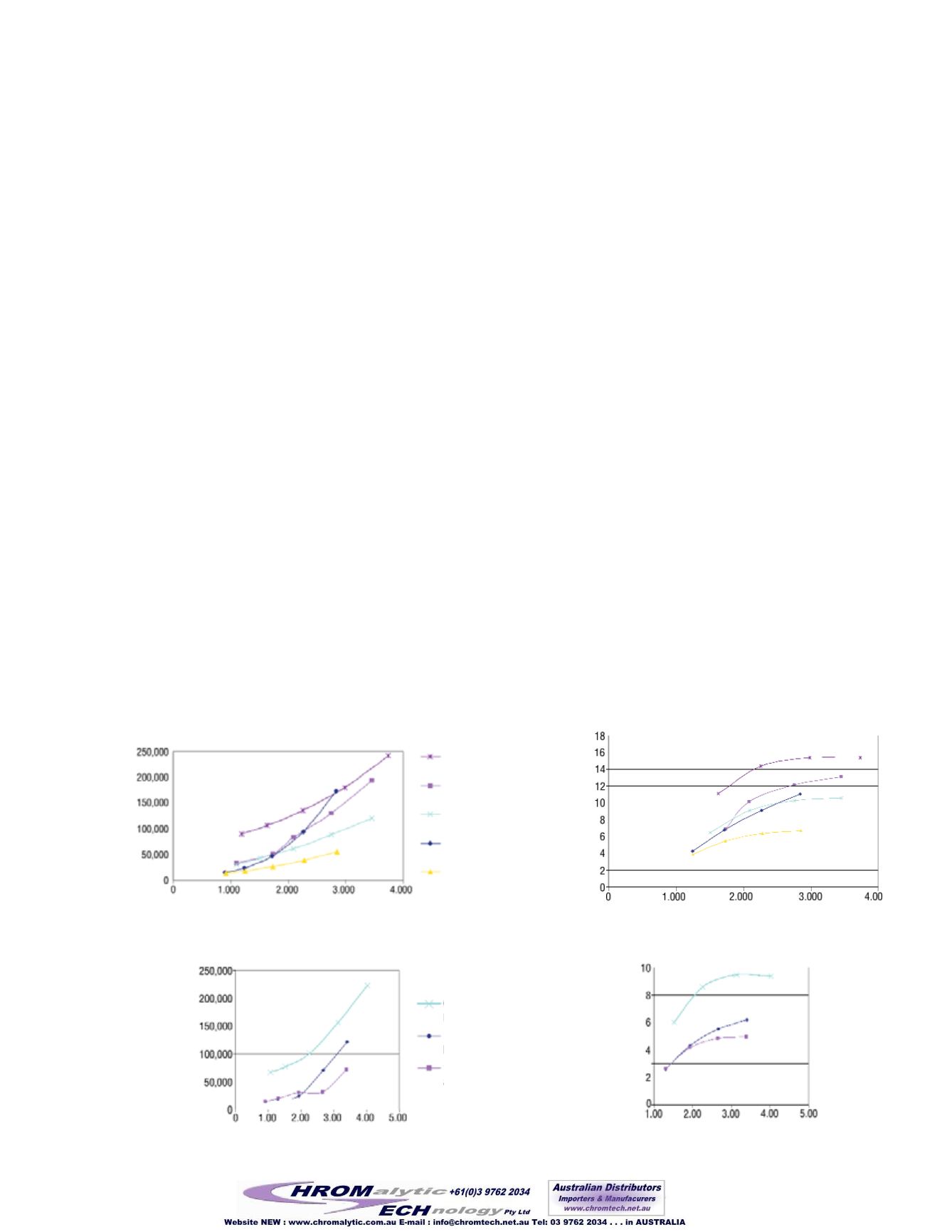

• 4 •
www.restekcorp.comExtracolumn Volume and its Effects in Gradient HPLC
To Maintain Efficiency and Resolution, Use Short Lengths of Narrow-Bore Tubing
✔
Amount
and
location
of extracolumn volume affect efficiency and resolution.
✔
Extracolumn volume
after
the column has greater effect than extracolumn volume
before
the column.
✔
150µL of extra volume can cut efficiency by almost 50%.
Effects of extracolumn volume on band broadening,
and the resulting chromatography, have been well
studied and documented. These investigations, how-
ever, have primarily explored effects in isocratic sep-
arations. In this investigation, we have taken a prac-
tical look at extracolumn volume in gradient analy-
ses, and studied the effects on actual separations.
The data we have obtained show that the location of
extracolumn volume in the sample flow path, as well
as the amount of extracolumn volume, has a nega-
tive effect on theoretical plates (efficiency) and reso-
lution. These extracolumn effects, in combination
with the variables of column dimension and analyte
retention, play important roles in the resulting chro-
matography.
To establish baseline chromatographic perform-
ance, we analyzed a homologous series of com-
pounds consisting of toluene, ethylbenzene,
propylbenzene, butylbenzene, and pentylbenzene
on an optimized Agilent series 1100 chromato-
graph, using a 150 x 4.6mm Pinnacle II
™
C18
column (5µm packing) and a methanol gradient
(80-100% in 10 min.) or a 50 x 4.6mm
Pinnacle II
™
C18 column and methanol gradient
(80-100% in 3.3 min.). After establishing per-
formance baselines, we added PEEK
®
tubing of a
known internal volume to the sample flow path,
ahead of the column or after the column, and
repeated the analysis.
Effect of Extracolumn Volume and Location:
15cm Column
Figures 1a and 1b show the effect on efficiency
(plates/meter, N/m) and resolution caused by
increased extracolumn volume when using a 150 x
4.6mm C18 column under gradient conditions.
Chromatographic performance deteriorates, as
expected. Unlike observations from isocratic sepa-
rations, however, extracolumn volume in the por-
tion of the sample path between the column and the
detector has a more significant effect than extracol-
umn volume in the tubing, connections, guard col-
umn, etc. located before the column inlet. In fact,
for the later-eluting compounds in the test mix,
150µL of extra volume after the column had the
same effect as 500µL of extra volume before the
column.
Effect of Extracolumn Volume and Location:
5cm Column
Figures 1c and 1d show the effect on efficiency and
resolution caused by adding extracolumn volume
when using a 50 x 4.6mm C18 column. The effects
are, overall, equivalent to those observed with the
150 x 4.6mm column. Since the peak volume is
much smaller for this shorter column, however,
equal amounts of extracolumn volume have greater
effect than on a 150mm column. In this system,
150µL of extra volume before the column reduced
efficiency by 46%, whereas with the 150mm column
the loss in efficiency was only 20%.
Conclusions
In a gradient analysis, the location of extracolumn
volume in the sample flow path can be equally
important to the amount of extracolumn volume in
its effects on chromatographic performance. In par-
ticular, extra volume after the column should be
reduced. This is especially important for fast analy-
ses on short columns.
For any HPLC separation, it is best to keep tubing as
short and the ID as narrow as practical. Additionally
it is wise to use precut stainless steel tubing, or
PEEK
®
tubing cut with a guillotine-style cutter, to
ensure square, burr-free ends for minimal dead vol-
ume at connections.
For an extensive selection of tubing, low-volume fit-
tings, and related tools, request our HPLC catalog
(lit. cat.# 59241A).
Figure 1
— Extracolumn volume after the column has greatest negative impact on efficiency and resolution in gradient analysis, as shown by
consistently lowest values for plates/meter and resolution versus k.
15cm column
a) efficiency
b) resolution
5cm column
c) efficiency
d) resolution
N/m
resolution
resolution
N/m
k
k
k
k
Gradient: 80–100%
methanol in 10 min.
150µL, before the column
150µL, after the column
500µL, before the column
500µL, after the column
Gradient: 80–100%
methanol in 3.3 min.
150µL, before the column
150µL, after the column
By Randy Romesberg, HPLC Applications Chemist


















